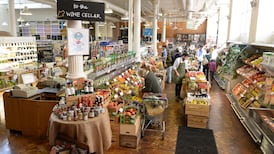ECONOMICS:There has been a flood of forecasts recently about the economy's performance this year and next. Against this background, it is useful to take a reality check on what is actually known about the economy's health thus far in 2007.
An interim statement on the economy's performance in the first half of 2007 is presented in Table 1. It shows how the economy fared in that period relative to the first half of 2006 in volume terms.
It is readily apparent that Irish economic performance in the first half of this year can barely be faulted. Tangible economic progress was achieved across the board.
Real gross domestic product (GDP) was 6.7 per cent higher than in the first half of 2006, while real gross national product (GNP) showed a gain of 5.7 per cent over the same period.
The labour market put in a similarly good showing in the first six months of this year. The average numbers at work were 77,000 higher than in the first half of 2006, representing an employment advance of 3.8 per cent.
Unemployment edged up from 90,000 to 95,000 over the period, but the unemployment rate remained at a respectable 4.4 per cent.
The only slight tinge of disappointment in the first half was evident in data on consumer spending on goods and services. Consumer purchases exert a powerful influence on domestic economic activity, since they account for more than half of all home spending.
With employment rising by 3.8 per cent, the budget tax cuts crystallising in pay packets and the "big bang" of maturing SSIA accounts during the spring, real consumer spending might have been expected to rise by more than 5.8 per cent in the first half of the year.
Clearly, SSIA recipients are keeping their cash close to their chests.
Exports did put in a strong performance, growing by 7.7 per cent, while Government consumption - the net day-to- day spending of the public authorities - showed an excessively large real increase of 6.2 per cent, compared to the first half of 2006.
The big surprise in the first half of the year has been the muscular performance of gross fixed investment. The volume of gross investment spending was 9.6 per cent higher in the first half of 2007 than in the first half of 2006.
The strength of fixed investment spending in the first half of the year was attributable to booming business spending on plant and equipment and a leveraging up of non-residential construction - powered principally by much higher public investment under the National Development Plan. Only new housebuilding started to show signs of weakness.
So, given this solid first-half performance, is there cause for concern?
The first point to make is that the economy will exhibit substantial growth this year.
While the forecasters have trimmed back their initial projections, real economic growth in Ireland during 2007 is still expected to range between 4 per cent and 5 per cent.
In the second place, year-on- year growth in the economy in the second half of 2007 will be substantially slower than in the first half, perhaps of the order of 2.5 per cent to 3 per cent. The principal reason for this is the slump in new housing construction.
Building and construction accounted for almost one-quarter of all spending on Irish GNP in 2006. Within the construction sector itself, new housebuilding comprises some 60 per cent of activity. Thus, new house building alone comprised almost 15 per cent of GNP last year. Because of its scale, changes in housebuilding exert a large impact on GNP.
Analysis by Robbie Kelleher of Davy Stockbrokers shows that, on a year-on-year basis, new housing construction marked time in the first quarter of this year before slipping by almost 8 per cent in the second quarter. Davy anticipates that housing output will fall by 25 per cent in the second half of the year, knocking the wind out of second-half GNP growth in the process.
A broadly similar picture is painted by the Central Bank in its latest quarterly bulletin.
While housing completions held up fairly well in the first seven months of 2007, the bank says that leading indicators for the residential housing sector "point to a significant fall-off in activity in coming months, although most of the fall in activity is expected to affect next year rather than this year".
Thus, new housebuilding activity is the only real blot on the economic landscape this year. Elsewhere, the economy should continue to perform quite respectably through the remainder of 2007.
The slippage in new house completions should not invite any direct intervention from Government. Housing looms too large in the economy. The level of housing output - 88,000 completions last year - is too big and prices are too high. There is a mechanism for dealing with such problems. It is called the market. Let it do its work.










